child seat CHEVROLET BLAZER 1997 2.G Owners Manual
[x] Cancel search | Manufacturer: CHEVROLET, Model Year: 1997, Model line: BLAZER, Model: CHEVROLET BLAZER 1997 2.GPages: 402, PDF Size: 21.93 MB
Page 8 of 402
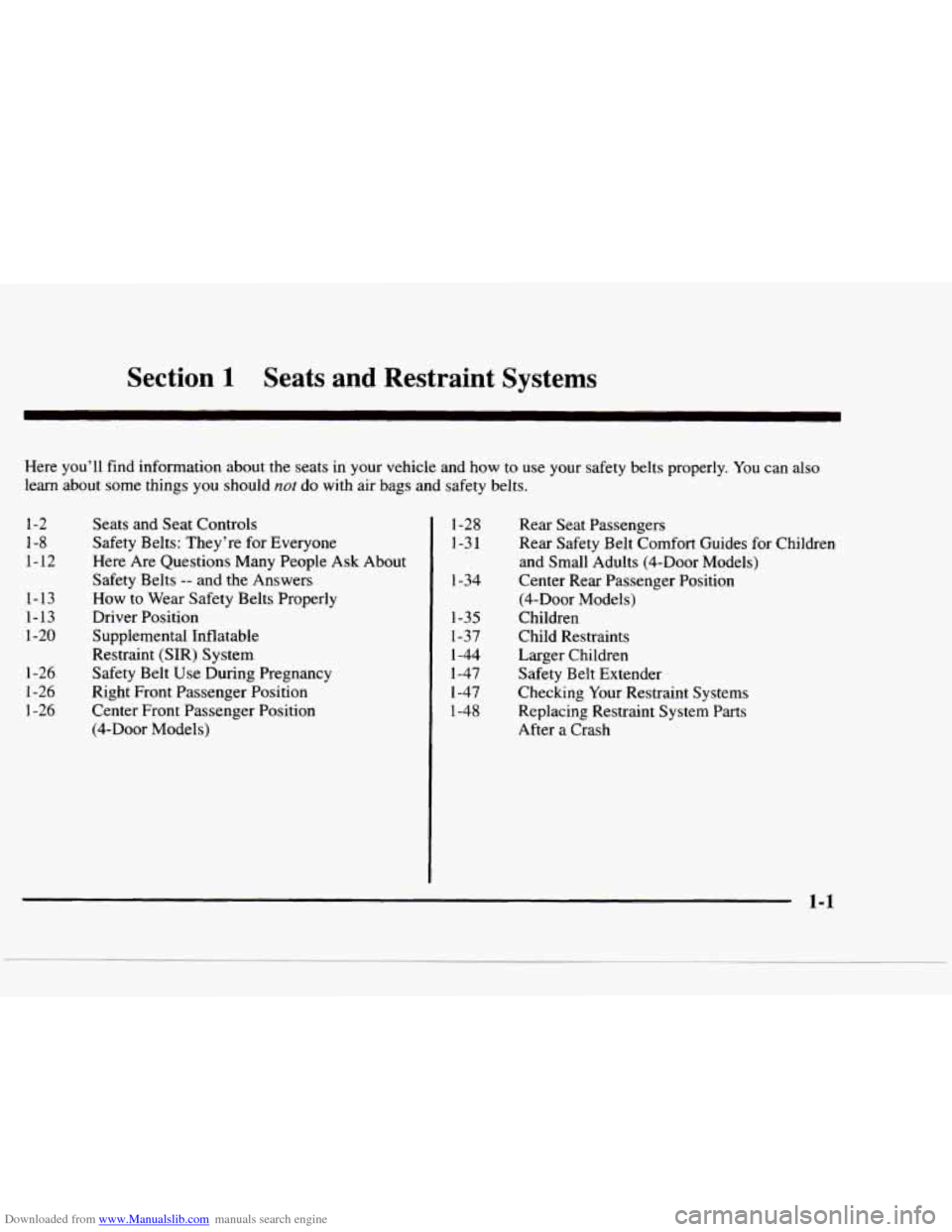
Downloaded from www.Manualslib.com manuals search engine Section 1 Seats and Restraint Systems
Here you’ll find information about the seats in your vehicle\
and how to use your safety belts properly. You can also
learn about some things you should
not do with air bags and safety belts.
1-2
1-8
1-12
1-13
1-13
1-20
1-26
1-26
1-26
Seats and Seat Controls Safety Belts: They’re for Everyone
Here Are Questions Many People Ask About
Safety Belts
-- and the Answers
How to Wear Safety Belts Properly
Driver Position
Supplemental Inflatable
Restraint (SIR) System
Safety Belt Use During Pregnancy
Right Front Passenger Position
Center Front Passenger Position
(4-Door Models)
1-28
1-31
1-34
1-35
1-37
1-44
1-47
1-47
1-48
Rear Seat Passengers
Rear Safety Belt Comfort Guides for Children
and Small Adults (4-Door Models)
Center Rear Passenger Position
(4-Door Models)
Children
ChiId Restraints
Larger Children
Safety Belt Extender
Checking Your Restraint Systems
Replacing Restraint System Parts
After a Crash
Page 20 of 402

Downloaded from www.Manualslib.com manuals search engine If I’m a good driver, and I never drive far from
home, why
should I wear safety belts?
A: You may be an excellent driver, but if you’re in an
accident
-- even one that isn’t your fault -- you and
your passengers can be hurt. Being a good driver
doesn’t protect you from things beyond your
control, such as bad drivers.
Most accidents occur within
25 miles (40 km) of
home. And the greatest number of serious injuries
and deaths occur at speeds
of less than 40 mph
(65 km/h).
Safety belts are for everyone.
How to Wear Safety Belts Properly
Adults
This part is only for people of adult size.
Be aware that there are special things
to know about safety
belts and children. And there are different rules for smaller
children and babies. If a child will
be riding in your
vehicle, see the
part of this manual called “Children.”
Follow those rules for everyone’s protection.
First, you’ll want to know which restraint systems your
vehicle has.
We’ll start
with the driver position.
Driver Position
This part describes the driver’s restraint system.
Lap-Shoulder Belt
The driver has a lap-shoulder belt. Here’s how to wear
it properly.
1. Close and lock the door.
2. Adjust the seat (to see how, see “Seats” in the Index)
so you can sit up straight.
1-13
Page 38 of 402

Downloaded from www.Manualslib.com manuals search engine To unlatch the belt, just push the button on the buckle.
Rear Safety Belt Comfort Guides
for Children
and Small Adults
(4-DOOr Models)
Four-door models have rear shoulder belt comfort
guides. This feature will provide added safety belt
comfort for children who have outgrown child restraints
and
for small adults. When installed on a shoulder belt,
the comfort guide pulls the belt away from
the neck
and head.
There is one guide for each outside passenger position in the
rear seat. To provide added safety belt comfort for
children who have outgrown child restraints and for smaller adults, the comfort guides may be installed
on
the shoulder belts. Here’s how to install a comfort guide
and use the safety belt:
1-31
Page 44 of 402

Downloaded from www.Manualslib.com manuals search engine Child Restraints
Be sure the child restraint is designed to be used in a
vehicle. If it is,
it will have a label saying that it meets
Federal Motor Vehicle Safety Standards.
Then follow the instructions for the restraint. You
may
find these instructions on the restraint itself or in a
booklet, or both. These restraints use
the belt system in
your vehicle, but the child also has to be secured within
the restraint
to help reduce the chance of personal injury.
The instructions that
come with the infant or child
restraint will show you how to do that.
Where to Put the Restraint
Accident statistics show that children are safer if they
are restrained
in the rear rather than the front seat. We at
General Motors therefore recommend that you put your
child restraint in
a rear seat outside position unless the
child is an infant and you’re the only adult in the
vehicle. In that case, you might want to secure the
restraint in the right front seat where you can keep an
eye on
the baby.
Wherever you install it, be sure
to secure the child
restraint properly.
Keep
in mind that an unsecured child restraint can move
around
in a collision or sudden stop and injure people
in the vehicle. Be sure to properly secure any child
restraint in
your vehicle -- even when no child is in it.
1-37
Page 45 of 402
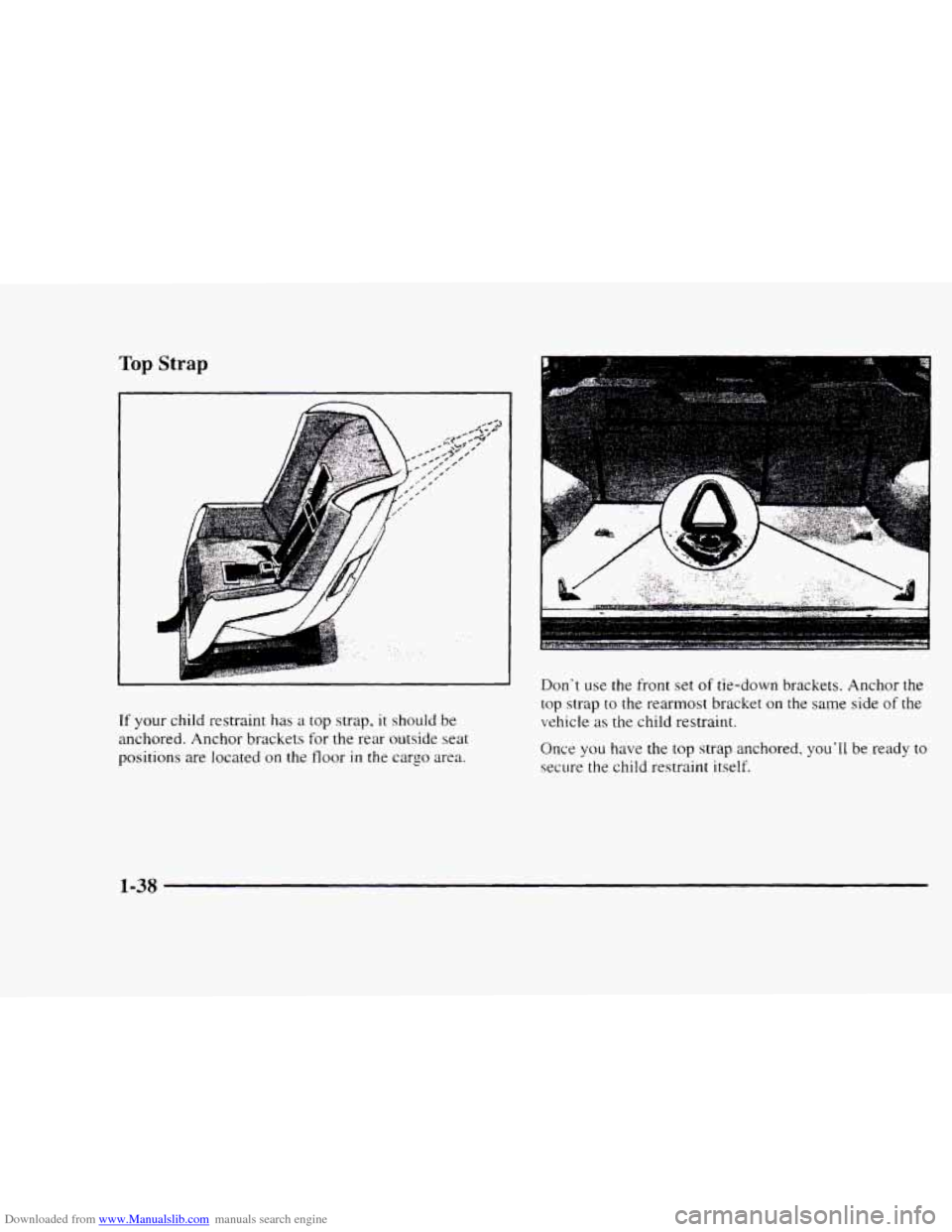
Downloaded from www.Manualslib.com manuals search engine Top Strap
If your child restraint has it top strap, it should be
anchored. Anchor brackets for the rear outside seat
positions
are located on the floor in the cargo area. Don't
use the front
set of tie-down brackets. Anchor the
top strap to the rearmost bracket on the same side of the
vehicle
as the child restraint.
Once
you have the top strap anchored. you'll be ready to
secure the child restraint itself.
1-38
Page 46 of 402
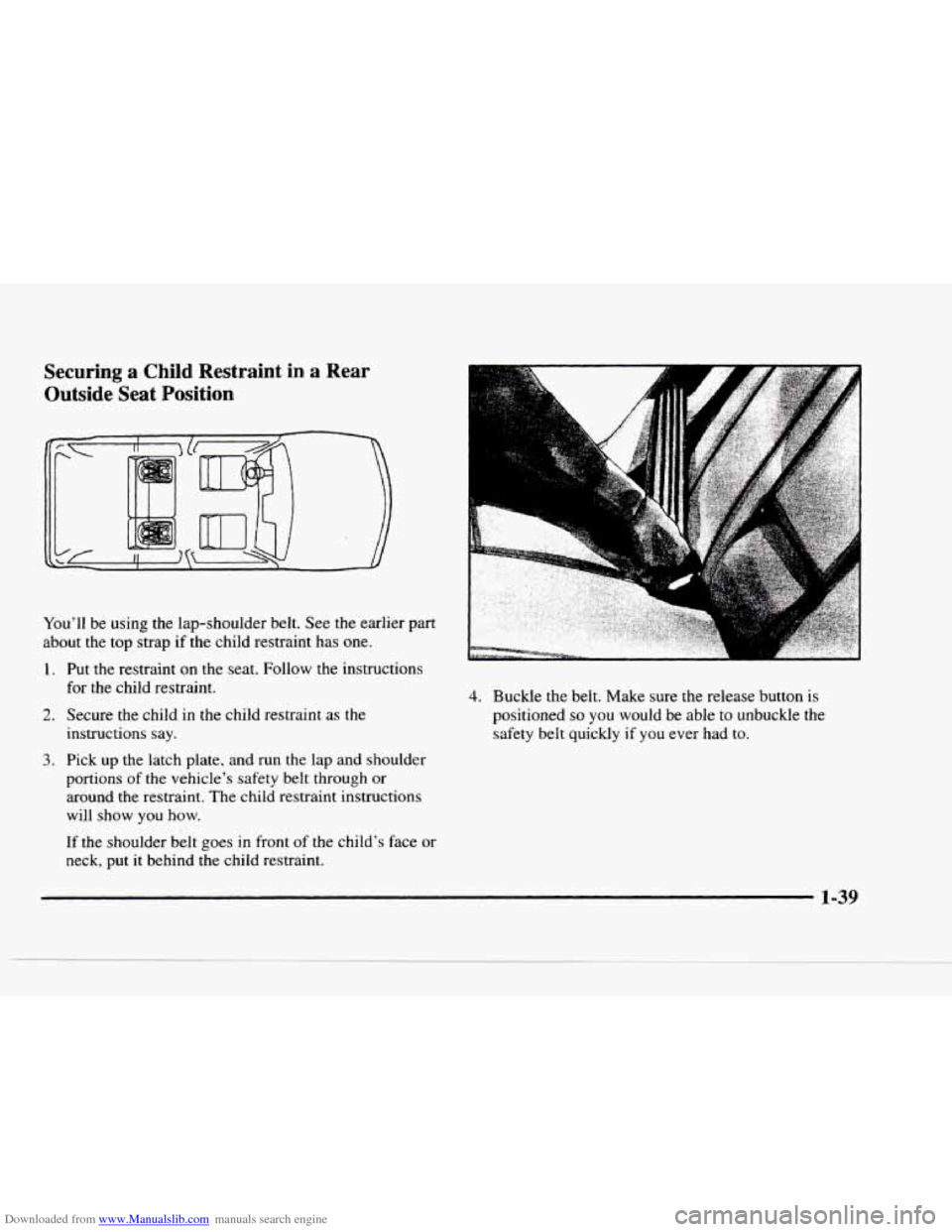
Downloaded from www.Manualslib.com manuals search engine Securing a Child Restraint in a Rear
Outside Seat Position
You’ll be using the lap-shoulder belt. See the earlier part
about the top strap if the child restraint has one.
1.
2.
3.
Put the restraint on the seat. Follow the instructions
for
the child restraint.
Secure the child in the child restraint as the
instructions
say.
Pick up the latch plate, and run the lap and shoulder
portions
of the vehicle’s safety belt through or
around
the restraint. The child restraint instructions
will show you how.
If the shoulder belt goes
in front of the child’s face or
neck, put
it behind the child restraint.
4. Buckle the belt. Make sure the release button is
positioned
so you would be able to unbuckle the
safety belt quickly if you ever had to.
1-39
Page 48 of 402

Downloaded from www.Manualslib.com manuals search engine Center Seat Positions (4-Door Models)
Don’t use child restraints in these positions. The
restraints won’t work properly.
Securing a Child Restraint in the Right
Front Seat Position
You’ll be using the lap-shoulder belt. See the earlier part
about the top strap if the child restraint has
one.
1.
2.
3.
Put the restraint on the seat. Follow the instructions
for
the child restraint.
Secure
the child in the child restraint as the
instructions say.
Pick up
the latch plate, and run the lap and shoulder
portions of
the vehicle’s safety belt through or
around
the restraint. The child restraint instructions
will show you how.
If the shoulder belt goes in front
of the child’s face or
neck, put it behind the child restraint.
1-41
Page 50 of 402
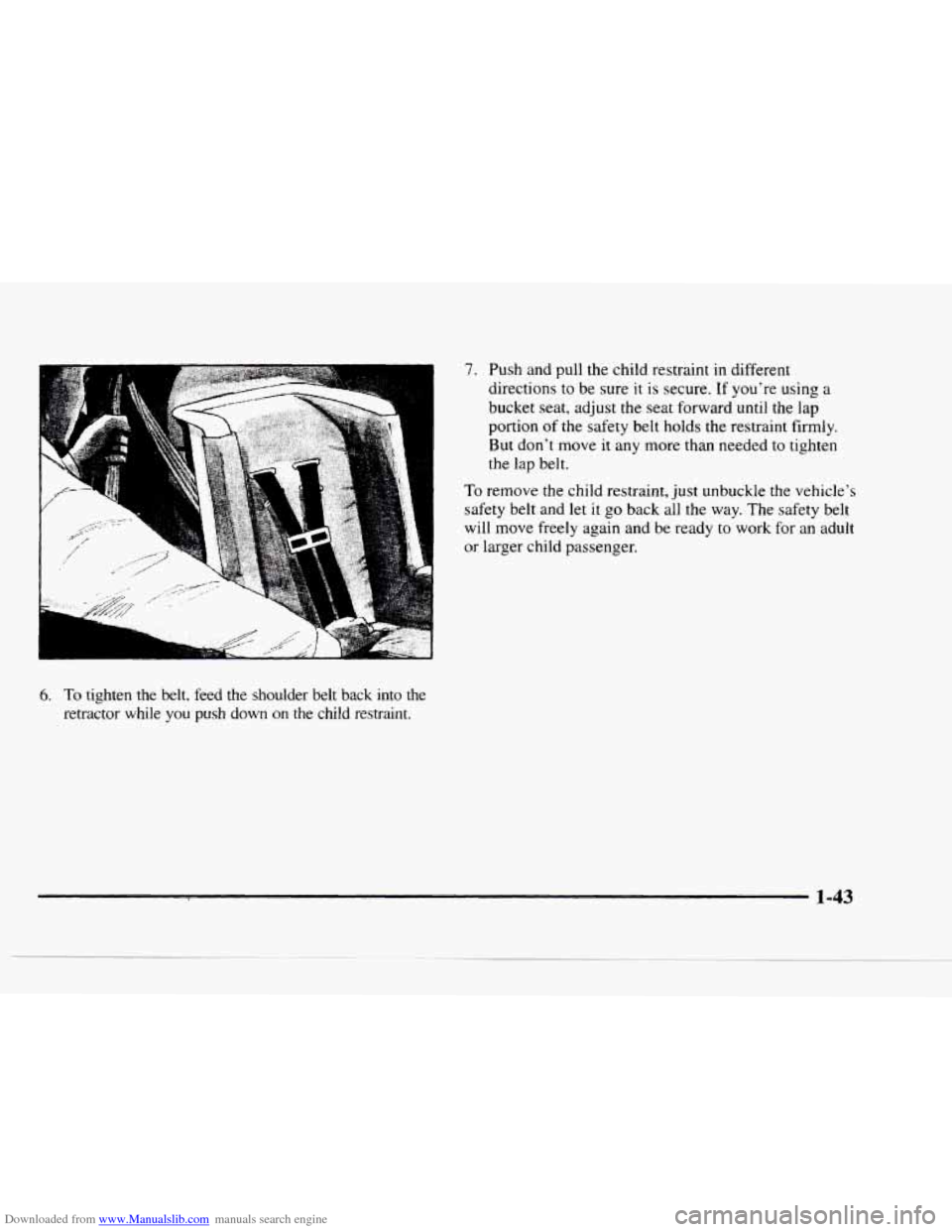
Downloaded from www.Manualslib.com manuals search engine I
6. To tighten the belt, feed the shoulder belt back into the
retractor while
you push down on the child restraint.
7. Push and pull the child restraint in different
directions to be sure
it is secure. If you’re using a
bucket seat, adjust the seat forward until the lap
portion of the safety belt holds the restraint firmly.
But don’t move
it any more than needed to tighten
the
lap belt.
To remove the child restraint, just unbuckle the vehicle’s
safety belt and let
it go back all the way. The safety belt
will move freely again and be ready
to work for an adult
or larger child passenger.
Page 51 of 402
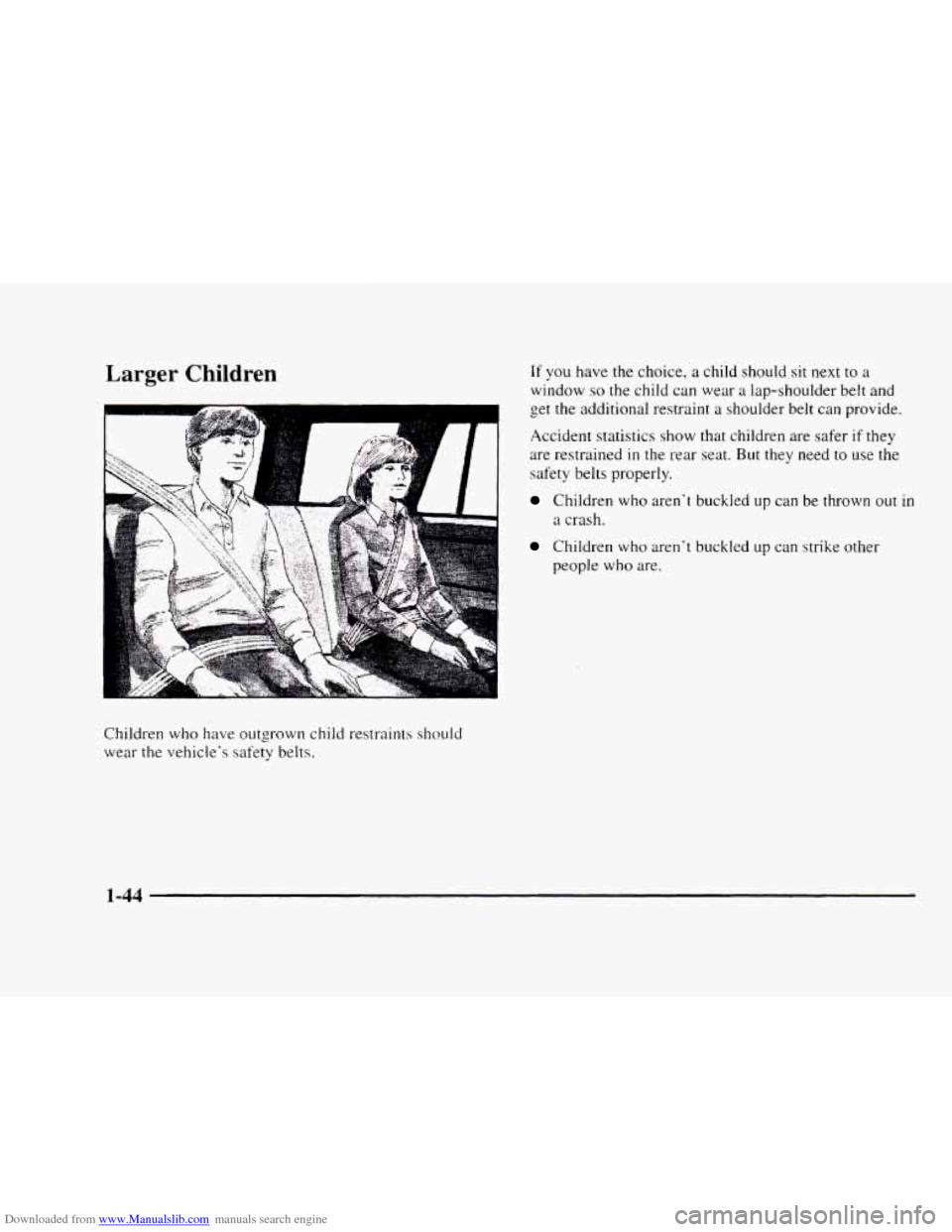
Downloaded from www.Manualslib.com manuals search engine Larger Children
Children who have outgrown child restraints should
wear the vehicle's safety belts.
If you have the choice, a child should sit next to a
window so the child can wear a lap-shoulder belt and
b oet the additional restraint a shoulder belt can provide.
Accident statistics
show that children are safer if they
are restrained
in the rear seat. But they need to use the
safety belts properly.
Children who aren't buckled up can be thrown out in
a crash.
Children who aren I ouckled up can strike other
people who are.
1-44
Page 52 of 402
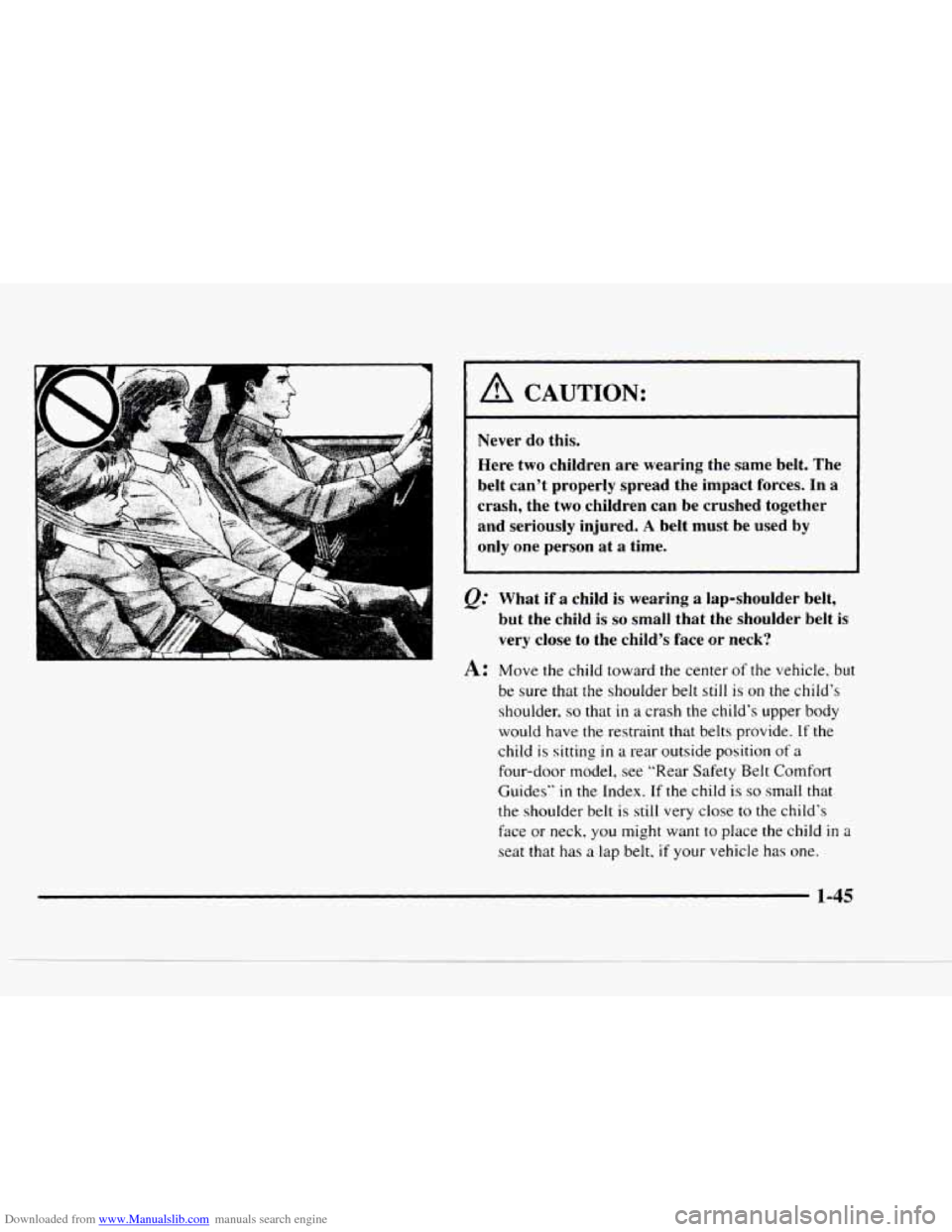
Downloaded from www.Manualslib.com manuals search engine -
/d CAUTION:
Never do this.
Here two children are wearing the same belt. The
belt can’t properly spread the impact forces. In
a
crash, the two children can be crushed together
and seriously injured.
A belt must be used by
only one person at
a time.
Q: What if a child is wearing a lap-shoulder belt,
but the child
is so small that the shoulder belt is
very close to the child’s face or neck?
A: Move the child toward the center of the vehicle, but
be sure that the shoulder belt still is on the child’s
shoulder,
so that in a crash the child’s upper body
would have the restraint that belts provide. If the
child is sitting
in a rear outside position of a
four-door model, see “Rear Safety Belt Comfort
Guides” in the Index. If the child is so small that
the shoulder belt is still very close to
the child’s
face or neck.
you might want to place the child in a
seat that has a lap belt, if your vehicle has one.
1-45